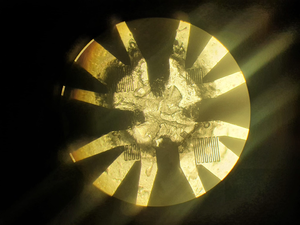Difference between revisions of "Experiments"
(→3rd semester: general and more detailed information about what we did and our findings) (Tag: Visual edit) |
(→3rd semester: general and more detailed information about what we did and our findings as well as some experiments conducted this semester) (Tag: Visual edit) |
||
| Line 12: | Line 12: | ||
- experiment 05/05/22 | - experiment 05/05/22 | ||
| + | |||
| + | Present during experiment: Lasse, Morten, Elizabeth & Daniel | ||
| + | |||
| + | Documented by: Lasse | ||
| + | |||
| + | We got some sharp visuals and did an ok job at manually tracking specific cells, but it doesn't seem like the cells responded to the field at all compared to older footage from January showing cell clusters rotating and ‘vibrating’ single cells. We assume the electrodes are too damaged now. | ||
| + | |||
| + | At some point (after around 30 minutes of normal operation) crystal formations spontaneously started to occur from the electrode edges in the PBS solution (see picture below), which we couldn't manage to record on video. Or more specifically, we had started to record but it stopped without us noticing and we couldn't start recording later either so there's possibly a technical issue with the software (FlyCap2, tried ‘image sequence’ and ‘video’, different formats) considering the ‘D:’ disk has ~2.5TB storage left. We have videos of the monitor filmed using a phone camera. | ||
| + | [[File:Bilde 2022-07-08 104253838.png|thumb|the foto shows the crystals fomed during the experiment, on the 05.05.2022]] | ||
| + | |||
| + | This could be a consequence of the electrodes having deteriorated over the semester after being damaged, presumably, by our old setup. Maybe material from the electrodes gradually increased the concentration of some element in our PBS solution until it triggered the reaction? Maybe the new PBS bottle was damaged? (Even though the same PBS was used the week before). | ||
| + | |||
| + | <nowiki>https://www.researchgate.net/post/What_are_the_crystals_formed_in_the_phosphate_buffer_solution_at_alkaline_condition</nowiki> | ||
| + | |||
| + | The crystal was easily dissolved by adding some water, possibly sodium-/potassium chloride or phosphate? The signal generator was turned on throughout all of this. The first crystallization happened after a large, sudden change of frequency (from 50 to 20 MHz) in a PBS solution, but the following crystallizations happened without this adjustment (still at 20 MHz) in a PBS/water mix so it's unclear if there’s a correlation. | ||
- crystalization experiment | - crystalization experiment | ||
Revision as of 10:46, 8 July 2022
1st-2nd semester: general information about what we did
Test of equipment and fundamental principles
To test the electrorotation equipment we replicated the methods and experiment done by Anders Jansen as well we compered dry and wet yeast.
We started by growing the dry yeast to a concentration of 8,8*10^7 cells per ml and the wet yeast to a concentration of 8,6*10^7 cells per ml, we calculated this as follows. 2 grams of dry yeast and 3,25 grams of wet yeast. We then calculate the given density of yeast cells in each yest type, which gives us 8,6*10^10 cells for wet yeast and 8,8*10^9 cells for the dry yeast. We then use the formula C1*V1=C2*V2 formula to calculate the given concentration of cells when we add 49,5 ml of tap water to each culture. we then add 2g of sugar to each culture acting as a food source. Each culture was then grown for 30 to 40 minutes giving the cultures depending on how active they appeared to be based on pressure and heat generation.
Cells from each culture where then placed in the electrorotation chamber and the equipment was tested, the equipment functioned as hoped and no difference was found between the cultures.
3rd semester: general and more detailed information about what we did and our findings
Lasse's notes here
- experiment 05/05/22
Present during experiment: Lasse, Morten, Elizabeth & Daniel
Documented by: Lasse
We got some sharp visuals and did an ok job at manually tracking specific cells, but it doesn't seem like the cells responded to the field at all compared to older footage from January showing cell clusters rotating and ‘vibrating’ single cells. We assume the electrodes are too damaged now.
At some point (after around 30 minutes of normal operation) crystal formations spontaneously started to occur from the electrode edges in the PBS solution (see picture below), which we couldn't manage to record on video. Or more specifically, we had started to record but it stopped without us noticing and we couldn't start recording later either so there's possibly a technical issue with the software (FlyCap2, tried ‘image sequence’ and ‘video’, different formats) considering the ‘D:’ disk has ~2.5TB storage left. We have videos of the monitor filmed using a phone camera.
This could be a consequence of the electrodes having deteriorated over the semester after being damaged, presumably, by our old setup. Maybe material from the electrodes gradually increased the concentration of some element in our PBS solution until it triggered the reaction? Maybe the new PBS bottle was damaged? (Even though the same PBS was used the week before).
https://www.researchgate.net/post/What_are_the_crystals_formed_in_the_phosphate_buffer_solution_at_alkaline_condition
The crystal was easily dissolved by adding some water, possibly sodium-/potassium chloride or phosphate? The signal generator was turned on throughout all of this. The first crystallization happened after a large, sudden change of frequency (from 50 to 20 MHz) in a PBS solution, but the following crystallizations happened without this adjustment (still at 20 MHz) in a PBS/water mix so it's unclear if there’s a correlation.
- crystalization experiment
